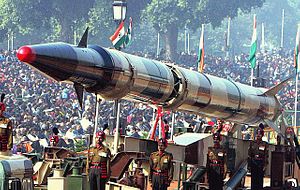Since its initiation by the Prime Minister’s Office in 2003, India’s nuclear doctrine, for all official purposes, has revolved around the doctrine of credible minimum deterrence (CMD). However, the recent developmental strides in missile technology made by the Defense Research and Development Organization (including the Agni V, BrahMos and Dhanush missiles) raises a question: Just how much is a “credible minimum?”
History will tell us about the perceived Chinese threat, which was the catalyst for India to test its first nuclear device in 1974. However the 1998 tests, conducted under the auspices of the newly instated BJP government, were more in line with regional prestige than with national security. This was also New Delhi’s hamartia (mistake). A threatened Pakistan, already on the fast-track to nuclear weapons, responded by testing its own devices, thus turning an already fractious region into one of the world’s most dangerous. As a counter, India’s leadership, still riding the wave of “peaceful nuclear explosions,” drafted a hurried and unplanned nuclear doctrine, which has since been subjected to ridicule.
A nuclear doctrine is primarily a containment strategy, as opposed to a standard operating procedure. When CMD was first found to be in tandem with New Delhi’s “peaceful objectives,” policymakers had to choose which of their two belligerent neighbors would be the focus of India’s nuclear posture. Unsurprisingly, China was expected to fill that role. However, given events already underway, India is now faced with an even greater threat in the form of a nuclear Pakistan, complete with a first use, India-centric nuclear strategy. New Delhi’s rhetoric of no first-use (NFU) notwithstanding, India is the catalyst for the arms race now underway for nuclear supremacy in the region, as it is practically impossible to gain “credible minimum” deterrence against both of its geopolitical opponents. China’s nuclear power, far surpassing India’s own, would require much more extensive measures and a larger arsenal to be credibly deterred. And this development would be anything but minimal with respect to Pakistan’s nuclear portfolio. To catch up to China, India will constantly be challenging Pakistan to an unintended nuclear defense dilemma.
India’s nuclear strategy mainly draws its deterrence from the clause on punitive retaliation. Theoretically, New Delhi wants to neutralize any threat of a nuclear attack by amassing the “credible minimum” firepower and capability required to deliver a punitive retaliatory measure, which can ensure gross destruction of the opposing forces, conforming to the doctrine of Mutually Assured Destruction (MAD). New Delhi has achieved considerable success on that front by having worked to prove India’s credibility regarding the Non-Proliferation Treaty (NPT) regime, having successfully signed a nuclear deal with the U.S., and making enormous development strides in its defense research and development with the induction of the Prithvi Air Defence System, the INS Arihnat, and the Agni series of ballistic missiles. However, as discussed earlier, these developments have not contributed significantly to enhancing India’s own relative posture in the region. Pakistan has been drawn into playing catch-up, thus posing a serious risk to the entire region, while Beijing has started taking notice of this development, and could possibly step up its border defense network.
Pakistan for its part has a completely viable nuclear strategy, which pivots on India. The provision for a first strike can be attributed to Pakistan’s fear of a conventional attack by the full might of the Indian armed forces, which might easily overrun its borders without bringing nuclear weapons into the equation. However, Islamabad’s ‘Option-enhancing Policy (OeP),” relies to a great extent on the rationality of the Indian political leadership. The question becomes whether a limited, tactical nuclear attack on a single battalion of the Indian Army, 50 km away from Lahore, merits the destruction of the entire state of Pakistan. It is this rationality that has kept India from engaging Pakistan militarily on occasions such as the Parliament attack in 2004 and the Mumbai terror attacks of 2008. To this extent, a CMD has only proved to be detrimental to India’s deterrence stand.
China officially does not recognize India as a nuclear power, and in the past has not paid much attention to New Delhi’s development curve. However, there has been considerable literature from Chinese academia recently concerning India’s foray into the manufacturing and setting up of its indigenous air defense system. Recently India and Israel concluded an agreement to jointly develop a ballistic missile defense shield against nuclear attacks from Pakistan and China. This would be of much interest in Beijing, as it shows India’s pursuit of a multi-layered defense, as opposed to its conventional military strategy regarding China. India’s first indigenous nuclear ballistic missile submarine (SSBN), the INS Arihant is also expected to start operations from early 2015, and will be directly concerned with the Chinese presence in the Indian Ocean. Given these circumstances, New Delhi may have alerted Beijing to the presence of a rising geopolitical threat, and the containment measures planned by the Chinese may prove detrimental to India. In this case too, the CMD has only aggravated problems for India.
In hindsight, nation states often produce weapons before drafting and adopting sound, feasible policies to dictate their utility. The U.S. and the U.S.S.R. during the Cold War learned this the hard way. It is for this reason that the U.S. and Russia together account for more than 75 percent of the nuclear weapons in the world today. Although not entirely the same context, unless the nation states of South Asia amend their internal policies to bring them in tandem with the fast evolving geopolitics of the region, the threat of a nuclear conflict appears considerable.
































